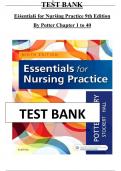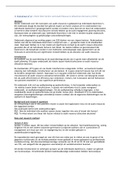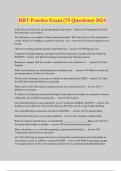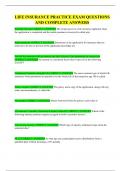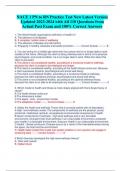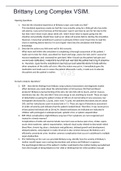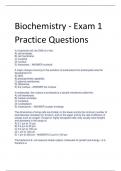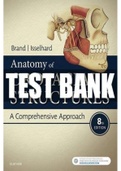1. Ten Principles of reflection of the cost of production including an
𝑃 = 𝑓(𝑄𝐷 )
element of profit which is sufficient to keep them in
Economics that line of production.
Economics is a science which studies human
behaviour as a relationship between ends & scarce
means that have alternative as well as the way in
which households & firms take decisions & how they
interact in markets.
The M&T Principles
How people take decisions Perfect competition:
A higher price has 2 effects:
1. People face trade-offs - has many buyers and sellers
2. The cost of something is what you give up to - has perfect information I. Income effect
get it (thinking in terms of marginal benefits - buyers & sellers are pricetakers
as purchasing power falls → Qd falls
& costs → you decide second by second) - has homogeneous goods
3. Rational people to incentives - buyers & sellers act independently II. Substitution effect
4. People respond to incentives - buyers & sellers consider all costs & benefits
good becomes relatively less attractive compared
How people interact Demand to alternatives → Qd falls
5. Trade can make everyone better of Quantity demanded is the amount of a good that Market demand is obtained through a horizontal
6. Markets are usually a good way to organize buyers are willing and able to purchase at different summation of individual demand curves.
economic activity prices.
7. Governments can sometimes improve The market demand curve gives the quantity
The Law of Demand is the claim that, other things demanded at different prices assuming that other
market outcomes
equal the quantity demanded of a good falls when the factors are constant.
price of the good rises.
3. The Market Forces of Individual demand is how much a consumer is
A change in the price of a good results in a change in
the quantity demanded (= movement along the
Supply & Demand willing & able to buy at different prices. demand curve).
Market demand is how much all consumers are A change in other determinants of the demand result
The Assumptions of the Market Model
willing & able to buy at different prices. in a change of the demand (= movement of the
A market is a group of buyers & sellers of a demand curve).
How much quantity is demanded as a function of
particular good or service.
price:
The price buyers pay for goods in the market is a
𝑄𝐷 = 𝑓(𝑃)
reflection of the value or utility they get from
,A change in prices of other goods have different Market supply is obtained by horizontal summation
outcomes: of the individual supply curves.
- Complements The market supply curve considers the quantity
P(coffee) ↑ → Qd(sugar) ↓ supplied at different prices assuming that other
- Substitutes factors that affect supply are constant.
P(coffee) ↑ → Qd(tea) ↑
A change in the price of a good results in a change in
A change in consumers’ income can have different quantity supplied (= movement along supply curve).
outcomes:
A change in other determinants of quantity supplied
- Normal goods result in a change in quantity supplied (= movement A shortage is a situation in which quantity demanded
Y ↑ → Qd(apples) ↑ of supply curve). is greater than quantity supplied at the going market
- Inferior goods price.
A change in the profitability of other goods has two
- Y ↑ → Qd(noodles) ↓
different outcomes: Pr ices as Signals : How Pr ice s Allocate
Supply Res our ce
- P(wooden toys) ↑ → Qs(wooden chairs) ↑
Individual supply is how much a producer is willing - Goods in joint supply Price mechanism signals for buyers: price tells them
to sell at different prices. P(sheep meat) ↑ → Qs(wool) ↑ how much they have to give up to obtain a good or
service.
Market supply is how much all producers are Mar ke t Equilibrium
willing to sell at different prices. Price mechanism signals for sellers: price tells them
The equilibrium or market price is a situation where
what they can obtain if they produce a good or service.
The law of supply is the claim that, other things equal price is such that quantity demanded equals quantity
the quantity supplied increases as price increases. supplied.
How much quantity is supplied as a function of price: The law of demand and supply is the claim that the
price of any good adjusts to bring the quantity
𝑄𝑆 = 𝑓(𝑃)
supplied and the quantity demanded for that good
Inverse supply: into balance.
𝑃 = 𝑓(𝑄𝑆 ) Disequilibrium can happen in two ways:
A surplus is a situation in which the quantity
supplied is greater than the quantity demanded at the
going market price.
, An elastic demands occurs when the quantity
4. Elasticity & its demanded of a product responds intensively to a
change in the price.
Applications
An inelastic demand occurs when the quantity
Elasticity is a measure of the responsiveness demanded of a product does not change relative to a
(sensitivity) of quantity demanded or quantity change in the price.
supplied to one of its determinants.
The determinants of price elasticity of demand are:
The Price Elasticity of Demand
- Availability of Close Substitutes: demand
The price elasticity of demand is a measure of how tends to be more price elastic if close
much the quantity demanded of a good responds to a substitutes are available.
change in the price of that good. - Necessities vs. Luxuries: luxury goods have
a higher elasticity, necessary goods that
% 𝑐ℎ𝑎𝑛𝑔𝑒 𝑖𝑛 𝑞𝑢𝑎𝑛𝑡𝑖𝑡𝑦 𝑑𝑒𝑚𝑎𝑛𝑑𝑒𝑑
ℇ𝑞,𝑝 = cannot be substituted easily are mostly
% 𝑐ℎ𝑎𝑛𝑔𝑒 𝑖𝑛 𝑞𝑢𝑎𝑛𝑡𝑖𝑡𝑦 𝑠𝑢𝑝𝑝𝑙𝑖𝑒𝑑 inelastic.
Arc elasticity—Midpoint method (between 2 points): - Definition of the Market: narrowly defined
markets tend to be more elastic because it’s
(𝑄2 + 𝑄1 ) easier to find close substitutes. Broad
(𝑄2 − 𝑄1 )/[ ]
ℇ𝑞,𝑝 = 2 markets (soft drinks) are more price inelastic.
(𝑃 + 𝑃 )
(𝑃2 − 𝑃1 )/[ 2 2 1 ] - Proportion of Income Devoted to the
Product: if the product only takes up a tiny
Point elasticity method (at 1 point): p.59 amount of your income, it’ll be much more
(∆𝑄)/𝑄 price inelastic because even if it increases,
ℇ𝑞,𝑝 = it’ll still be cheap.
(∆𝑃)/𝑃
1 𝑃 - Time Horizon: if something changes price
= × over time (LR, SR), you might want to adapt
𝑠𝑙𝑜𝑝𝑒 𝑖𝑛𝑣𝑒𝑟𝑠𝑒 𝑑𝑒𝑚𝑎𝑛𝑑 𝑓𝑢𝑛𝑐𝑡𝑖𝑜𝑛 𝑄
yourself to switch to the cheapest option.
A rule of thumb: a flatter demand curve reflects a
more price elastic demand for given price & quantity.
A linear demand curve has a constant slope but a
different price elasticity of demand.
Inferior good have negative income elasticities.
Normal goods have positive income elasticities.
, An increase in quantity leads to an increase in TR if % 𝑐ℎ𝑎𝑛𝑔𝑒 𝑖𝑛 𝑞𝑢𝑎𝑛𝑡𝑖𝑡𝑦 𝑑𝑒𝑚𝑎𝑛𝑑𝑒𝑑
ℇ𝑞,𝑝 =
demand is price elastic; it leads to a decrease in TR if % 𝑐ℎ𝑎𝑛𝑔𝑒 𝑖𝑛 𝑃2
demand is price elastic.
ℇ𝑞,𝑝2 > 0 → 𝑠𝑢𝑏𝑠𝑡𝑖𝑡𝑢𝑡𝑒𝑠
When demand is price inelastic (a price elasticity less
than 1), price and total expenditure move in the same If the price of coffee increases, demand for tea will
direction. increase as much.
When demand is price elastic (a price elasticity ℇ𝑞,𝑝2 < 0 → 𝑐𝑜𝑚𝑝𝑙𝑒𝑚𝑒𝑛𝑡𝑠
greater than 1), price and total expenditure move in
If printers become more expensive, demand for ink
opposite directions.
will decrease.
If demand is unit price elastic (a price elasticity
The Pric e Elastic ity of Supply
exactly equal to 1), total expenditure remains
constant when the price changes. The price elasticity of supply is a measure of how
much the quantity supplied of a good responds to a
The I nc ome Elastic ity of Demands
change in the price of that good.
Income elasticity of demand is a measure of how % 𝑐ℎ𝑎𝑛𝑔𝑒 𝑖𝑛 𝑞𝑢𝑎𝑛𝑡𝑖𝑡𝑦 𝑠𝑢𝑝𝑝𝑙𝑖𝑒𝑑
much quantity demanded of a good responds to a ℇ𝑞,𝑝 =
% 𝑐ℎ𝑎𝑛𝑔𝑒 𝑖𝑛 𝑝𝑟𝑖𝑐𝑒
change in consumers’ income.
% 𝑐ℎ𝑎𝑛𝑔𝑒 𝑖𝑛 𝑞𝑢𝑎𝑛𝑡𝑖𝑡𝑦 𝑑𝑒𝑚𝑎𝑛𝑑𝑒𝑑 Arc elasticity—Midpoint method (between 2 points):
ℇ𝑞,𝑌 =
% 𝑐ℎ𝑎𝑛𝑔𝑒 𝑖𝑛 𝑖𝑛𝑐𝑜𝑚𝑒 (𝑄2 + 𝑄1 )
(𝑄2 + 𝑄1 )/[ ]
ℇ𝑞,𝑝 = 2
ℇ𝑞,𝑌 < 0 → 𝑖𝑛𝑓𝑒𝑟𝑖𝑜𝑟 𝑔𝑜𝑜𝑑 (𝑃 + 𝑃 )
(𝑃2 − 𝑃1 )/[ 2 2 1 ]
Higher income lowers demand. It is negative because
income and Qd move in opposite directions. Point elasticity method (at 1 point): p.59
ℇ𝑞,𝑌 ≥ 0 → 𝑛𝑜𝑟𝑚𝑎𝑙 𝑔𝑜𝑜𝑑 (∆𝑄)/𝑄
ℇ𝑞,𝑝 =
(∆𝑃)/𝑃
Higher income raises demand. 1 𝑃
= ×
0 ≤ ℇ𝑞,𝑌 < 1 → 𝑛𝑒𝑐𝑒𝑠𝑠𝑎𝑟𝑦 𝑔𝑜𝑜𝑑 𝑠𝑙𝑜𝑝𝑒 𝑖𝑛𝑣𝑒𝑟𝑠𝑒 𝑠𝑢𝑝𝑝𝑙𝑦 𝑓𝑢𝑛𝑐𝑡𝑖𝑜𝑛 𝑄
ℇ𝑞,𝑌 ≥ 1 → 𝑙𝑢𝑥𝑢𝑟𝑦 𝑔𝑜𝑜𝑑
T he Cro ss-P ri ce Elasti cit y o f Demands
An increase in price leads to an increase in TR if
demand is price inelastic; it leads to a decrease in TR The cross-price elasticity of demand is a measure
if demand is price elastic. of how much quantity demanded of one good
responds to a change in the price of another good.


